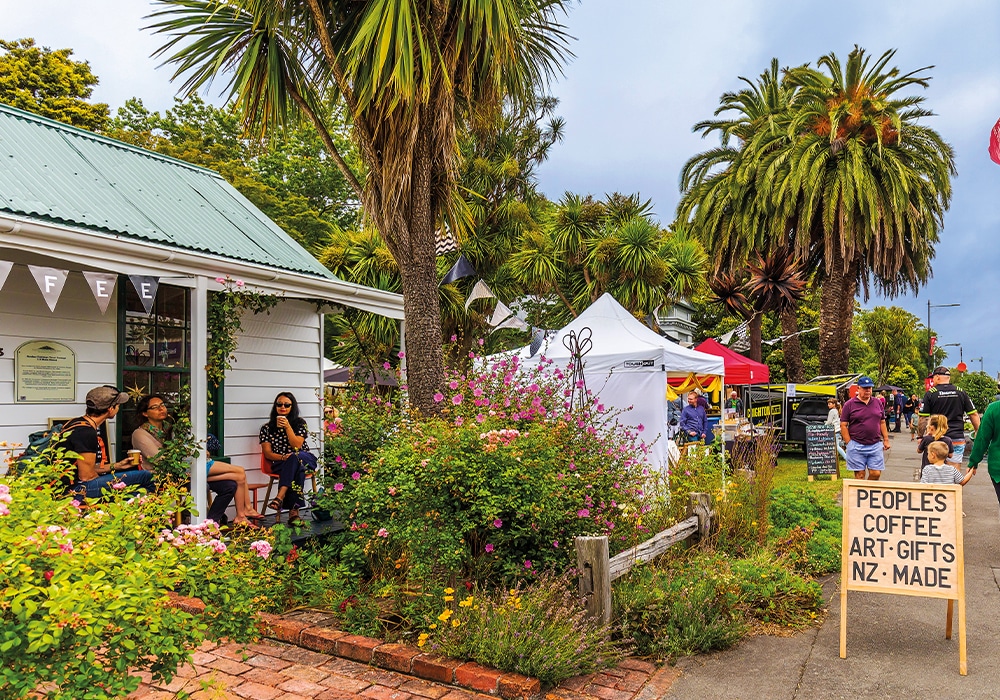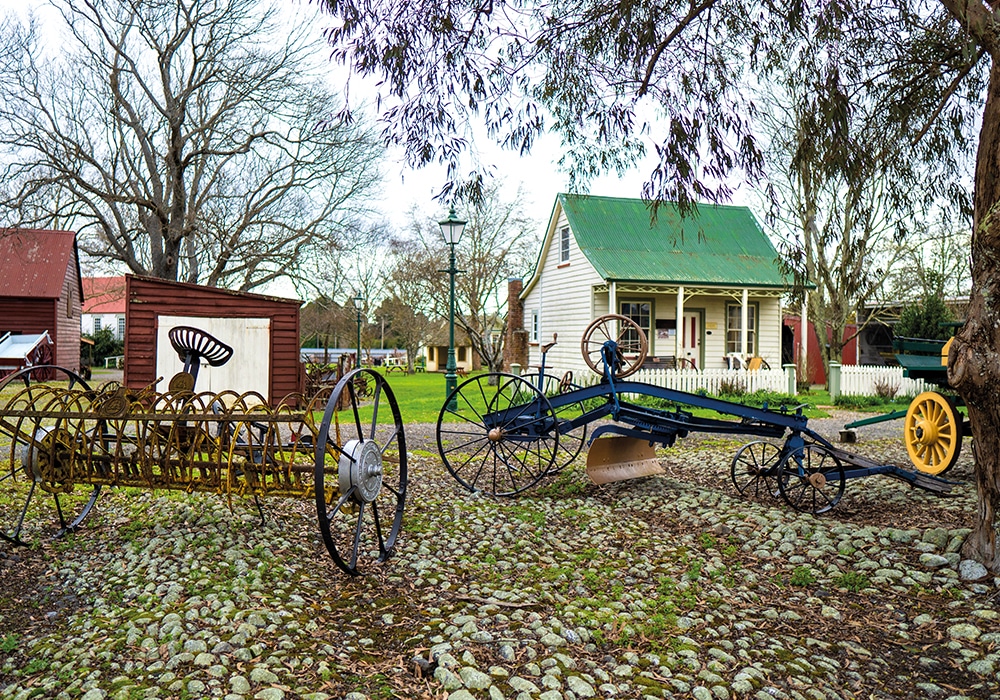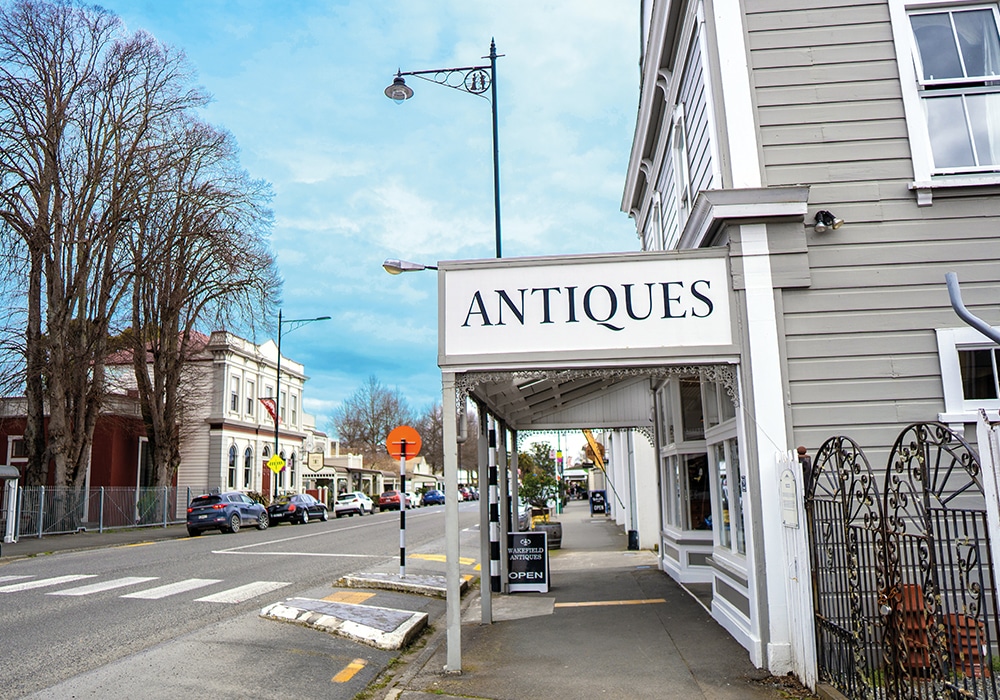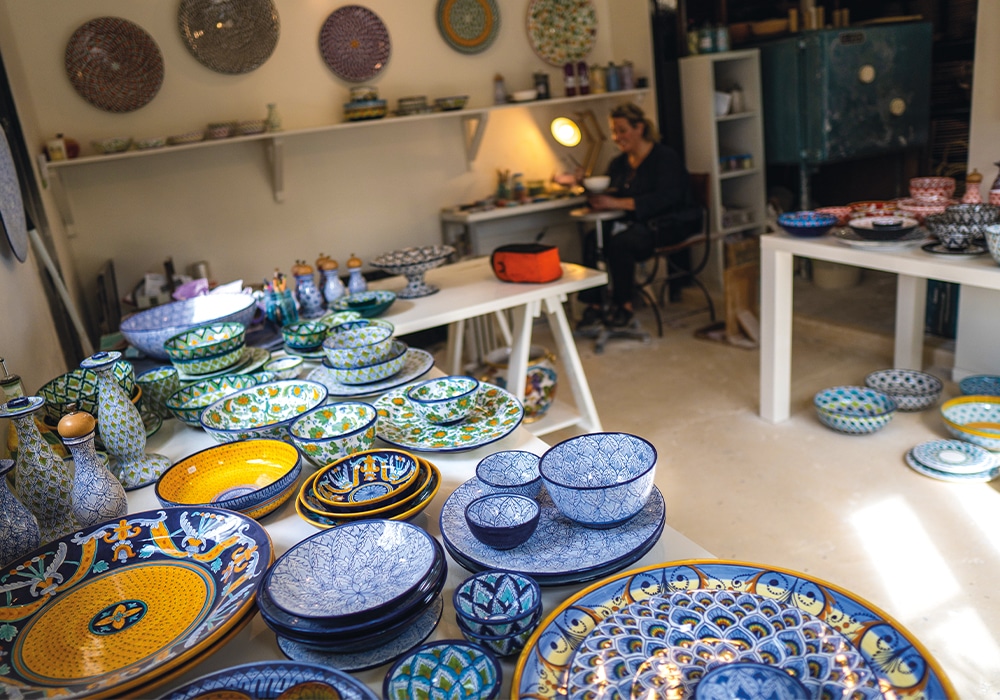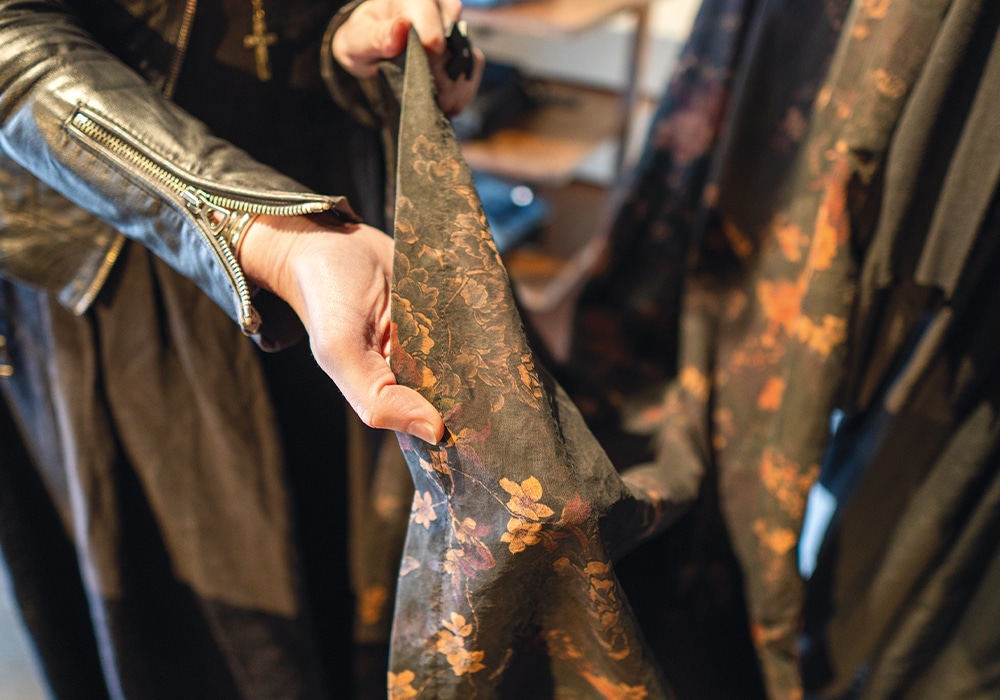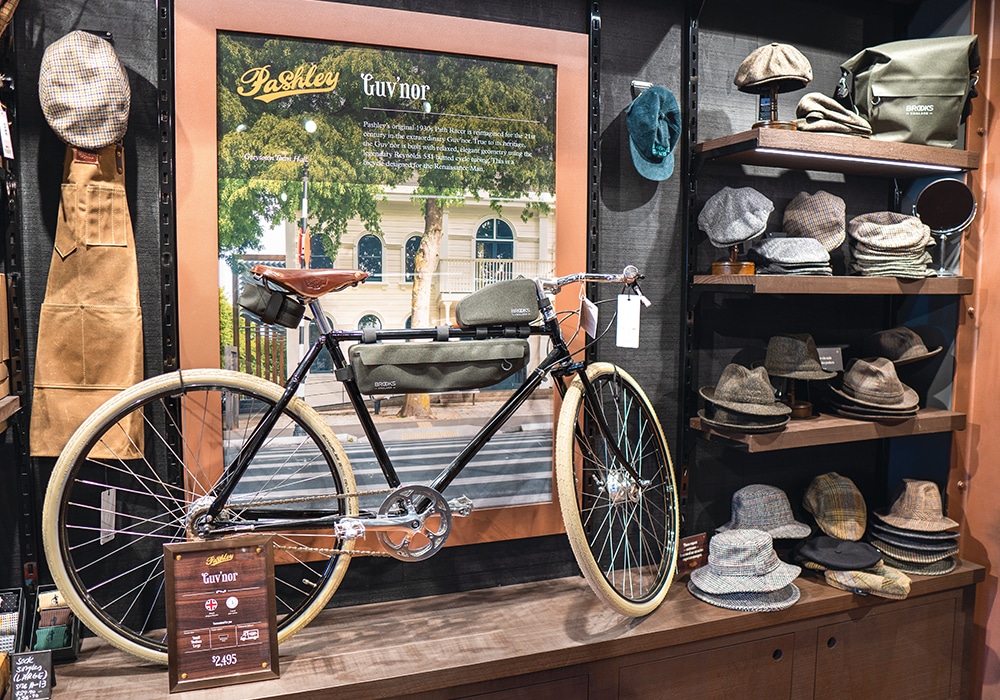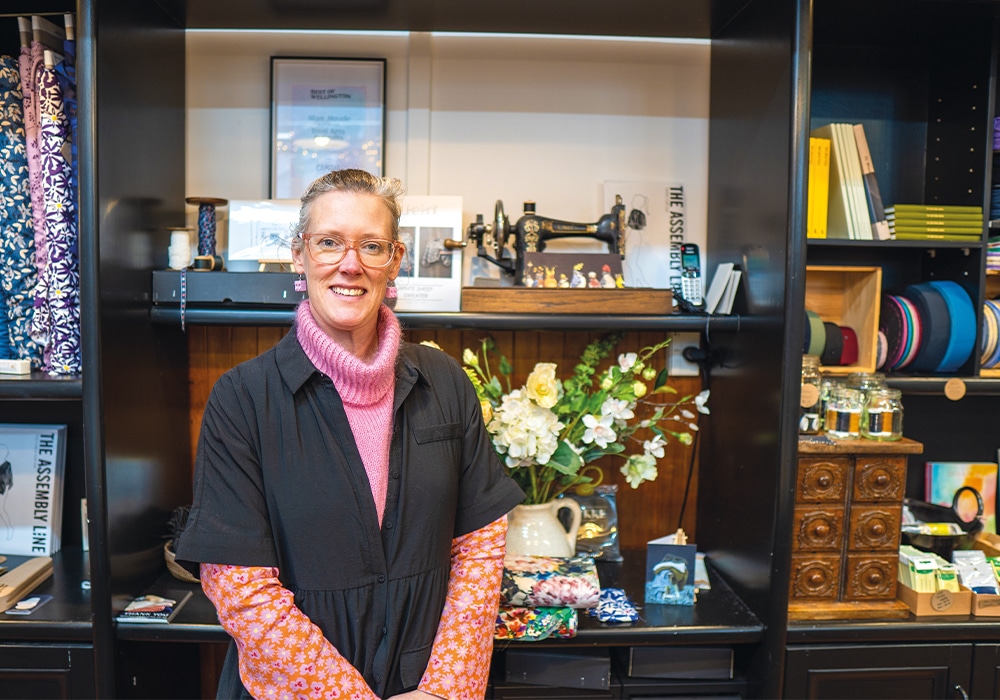For such a small town, Greytown punches well above its weight when it comes to the richness of its art, culture and history, says Paul Owen.
New Zealand is dotted with tiny townships we often drive through on the way to our next adventure. But in doing so, we might just bypass some of our greatest treasures. Each month, MCD highlights one of Aotearoa’s smaller towns so you can plan a stop, show them your support, and discover their hidden gems. This month, we’re stopping in Greytown.
At just 5.07sq km in area and with a population of under 4,000, the little settlement of Greytown, in the middle of the chain of towns that straddle State Highway 2 as it spears through the lower Wairarapa, has plenty to boast about. It became New Zealand’s ‘first planned town’ when initially settled by Europeans in 1854, marketed itself as ‘the fruit bowl of the Wairarapa’ throughout most of the 20th century, and was named ‘New Zealand’s Most Beautiful Small Town’ in 2017. That’s not bad going for a town with a Māori name – Te Hūpēnui – that translates to ‘Big Snot’ or more politely ‘the fluid that comes from your nose at a tangi’!
Named after the controversial governor who successfully negotiated the sale of Māori land for New Zealand’s first model town, Greytown has had its ups and its downs throughout its 170-year history. It soon grew to become the largest settlement in the Wairarapa region, but when it was bypassed by the railway line established between Masterton and Wellington in the 1880s due to flooding concerns, it began to decline. This would prove a blessing, as Greytown’s economic stagnation throughout the first half of the 20th century would allow it to retain an enviable collection of historic buildings today. When six of these were sensitively restored in 2016, it became a key factor in Greytown’s winning of the ‘Most Beautiful Small Town’ award the following year.
More recently, Greytown has been identified as one of the top five places in New Zealand to retire to by New Zealand media. However, ceramic artist, Josephine Durkin, didn’t come to Greytown to kick back and watch the world go by from the ornate veranda of her lovely 1860s home. Typical of many of the town’s creative natives, she came to transfer an artistic talent honed by 11 years of training in Umbria, Italy, to a New Zealand audience.
You’ll find Josephine in the backyard studio of OggiDomani ceramics at her West Street home, peacefully spending up to 26 hours in total to turn a fine piece of unglazed Italian pottery into a spectacularly mesmerising work of art. “Starting as an Italian ceramic studio’s business manager, I began painting at night to learn the age-old designs, then by day creating with our customers, new variations of the traditional Italian designs to work well within more modern lifestyles,” she told me. “On returning to New Zealand, I formed my own company, OggiDomani, bringing my favourite designs to loyal customers and new markets. Greytown proved to be the perfect place for me to do this dream – I absolutely love it here.”
Another Greytown artisan is Nicola Doggett, the fashion designer who first started her label in Wellington in 1990 before moving to Greytown and establishing the Nicola Screen Store on the town’s Main Street. Nicola sells her clothing and accessories exclusively online and at the Greytown ‘destination store’, pulling many visitors into the town who wish to see her designs up close instead of on a screen. Her hand-printed or silk-screened fabrics are best appreciated personally to get the full impression of their richness and textures. These are hand made into small batches of similar garments, giving each design bespoke exclusivity.
Using Greytown as a destination showcase to reinforce a high volume of online sales is obviously a popular business strategy for the town. Nowhere is this more apparent on the town’s Main Street than the attention-grabbing rival shops of the Blackwells. On the east side of the street is Mrs Blackwell’s Village Bookshop (estd. 1981), while slightly offset on the western side is the cycling and distinguished gentleman’s clothing and personal grooming emporium, Blackwell and Sons. Both appear to be trying to outdo each other when it comes to the theatrical shop-dressing of their wares.
One imagines that bookshop owner, Millie Blackwell, and her cycle shop husband, Adam Blackwell, have plenty of discussions about who has the better-presented business when they get home. Unfortunately, both Millie and Adam were on holiday when I visited Greytown, so I can’t confirm whether there is indeed a healthy business rivalry underpinning the couple. My personal opinion is that Millie’s is one of the top three book shops in the country, while Adam’s Anglophilic cycling/clothing/grooming enterprise can’t be compared to any other cycling shop in this country, although I suspect there may be similar in San Francisco and London.
Well done, Greytown! This energetic couple certainly added some extra style to the town when they moved there in 2012. With Millie absent, it was up to her assistant, Alice, a.k.a. Miss Floss, to show me around the bookshop. With her 1940s hairstyle and leather apron, Miss Floss could have stepped from the screen of a Jimmy Stewart movie, her style matching the shop’s 1904 cash register and the trio of art deco overhead lights above the counter. Looking beyond the counter, the shop is divided neatly into sections so that books relevant to particular subjects and genres are displayed together and become easy targets for customers to find. The modern fiction section was obviously Miss Floss’s favourite, full of emerging authors shortlisted for book awards rather than the more formulaic works of long established best-selling writers.
The sturdy traditional steel-framed bikes made by Pashley in Shakespeare country at Stratford-upon-Avon are the centrepieces of Blackwell and Sons, and they’re surrounded by the accessories, trad clothing, and grooming products made by Artifact, Brooks, Duke Cannon, Rustico and more. The shop therefore isn’t just about the bikes, and if you’ve got a beard to tame, a nice bottle of wine to carry elegantly, or just want a pair of socks to match some tweed trousers, this is the place. The shop’s website highlights Adam’s desire to create an environment that simply makes its visitors feel good.
“Blackwell and Sons is designed to help you feel something positive. Like you’ve made a great decision to look after someone you love, which could of course be yourself,” he says. “Like you care about the health of the body you inhabit. Like you have a deep appreciation for meticulous craftsmanship and design. Like you are wise with your money. Like you take time to think, observe, appreciate and be thankful for what you have.”
Just around the corner, located in the former Oddfellows Hall on Haswell Street, is Miss Maude, supplier of fine natural fabrics, haberdashery, and sewing supplies, both in the hall and online. Owner, Emma Smith, says that a lot of her customers are motorhomers who enjoy sewing while on the road, and get their supplies sent all over the country so when they finish one garment, they can start another. Miss Maude feels unashamedly retro, evoking memories of the places that your mum took you as a kid.
Greytown once had eight antique shops, but dwindling interest in old furniture and knick knacks has reduced the number to two. That’s if you count the Greytown Record Dispensary as an antique shop, as most of its trade is selling the vinyl records that attract a younger clientele than the few furniture pieces still on the floor attract. The other seller of secondhand treasure is Shane Brown’s Mango Interiors, which is an absolute trove of conversation starters for interior designers.
Need a break from all this Eurocentric culture? Nearby Pāpāwai marae is one of the most important in our history, as it was the focus of the Māori parliament movement during the late 19th century. The focal point of the marae is Hikurangi, the meeting whare which opened in 1888. It was here that meetings of the parliament were hosted in 1897 and 1898, where a resolution was passed to end sales of Māori land.
Biculturalism has long been a part of this marae. The 18 carved totara figures guarding it have one that represents Pākehā settler, William Smith, and the beautiful marble memorial in the grounds to Ngāti Kahungunu luminary, Hāmuera Tamahau Manupuku, was donated by local pākehā in thanks for his support for their integration into the community. Pāpāwai’s marae was an inspiring place to end our delightful sojourn to Greytown.
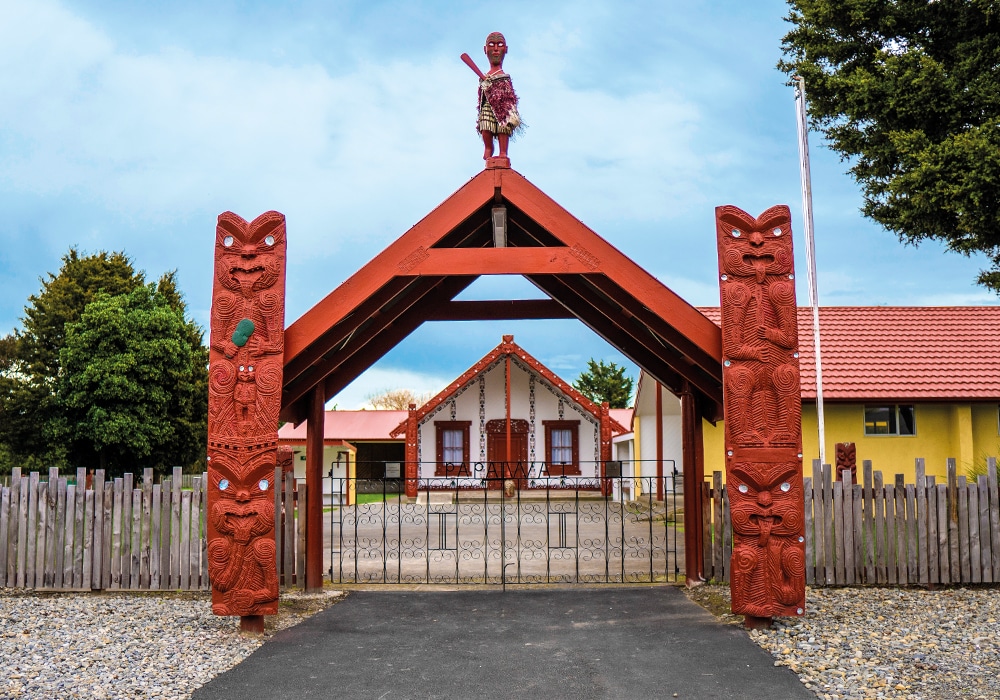
Five Must-Dos in Greytown
1. Ride the 5km Greytown-Woodside cycle trail, which travels over the railway branch line that serviced the town until 1953. You’ll travel through native bush, canopies of huge oak trees, and an arboreal arch created by the 117 lime trees planted in 1921 to honour the 117 soldiers from the town who never returned after the First World War.
2. Eat one of Murray Langham’s lime and chilli chocolate bars at the Schoc Chocolate Studio located at the Settlers Museum. Murray offers 80 other flavours if that town favourite is a little too hot to handle.
3. Check out the huge eucalyptus tree on the front lawn of the Anglican church. Does anywhere in Australia have a specimen that can shade this magnificent giant?
4. Let the kids loose on the inspirational playground in Kuratawhiti Street. It’s handily placed next to the Camping Ground at Soldiers Memorial Park.
5. Devour one of the fresh fruit ice creams available from the many fruit and vege shops at the northern end of the town, including the stalls of long-standing family orchards such as The Big Apple and Pinehaven.
Places To Camp
• The Greytown Camping Ground is an obvious place to stay, with affordable power sites for those in RVs, and a scattering of rustic gypsy caravans for those who don’t want to erect a tent for the night. It’s run by Ken Ryan, who teaches during schooldays, and returns to open the camp office at 5pm. The camping ground is located an easy walk from Greytown’s main street shops and is fringed with mature native bush. You wake up to the full New Zealand native bird chorus. Visit greytowncampground.co.nz
• For NZMCA members wishing to park near the town, there are three parkover properties (POPs) to choose from. John Bull’s property at 21 Wood Street welcomes CSC vehicles only, and allows small dogs to stay, as does Bush House at 529 Bidwills Cutting Road. Morrisons Bush is a peaceful POP located next to the Ruamahanga river that offers enticing swimming and fishing opportunities. You’ll find it at the end of Glenmorven Road.

